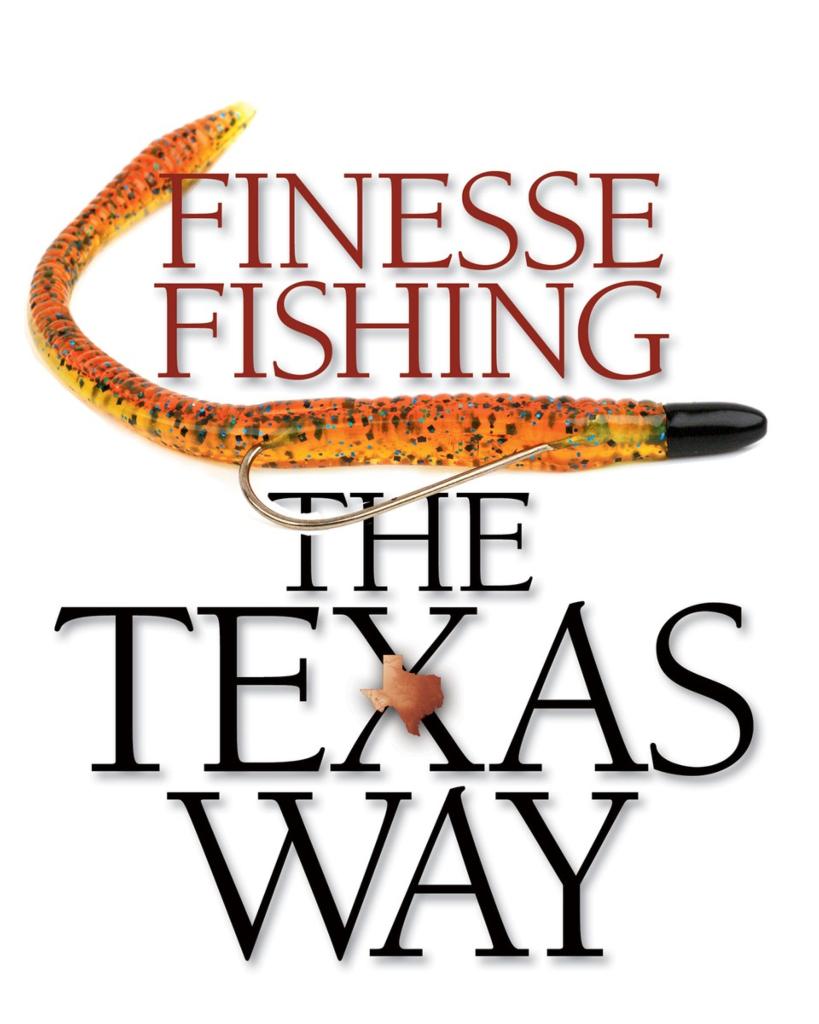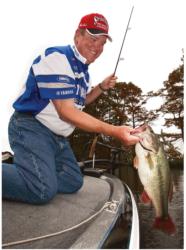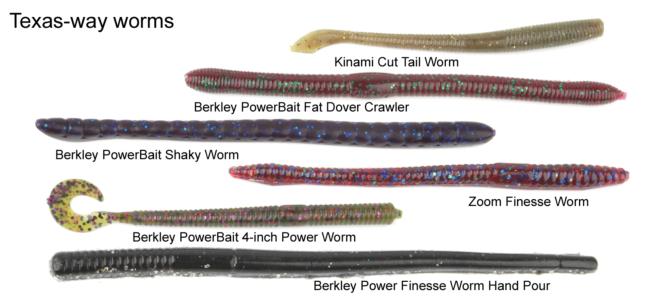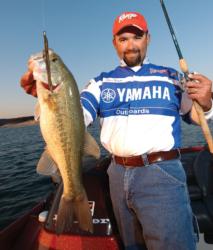Finesse-fishing the Texas way
Finesse-fishing a Texas rig can produce on all waters

The words “finesse” and “Texas” aren’t generally used in the same sentence.
When an angler mentions Texas, he’s usually talking about big bass and strong, heavy tackle to catch them. The Texas rig, by extension, is designed to bull its way into heavy cover or rocky structure where big fish hide, and it’s tough enough to get them out, too.
Of course, the Texas rig has a softer side. When a rapid weather or water change shocks fish into inactivity, or when you’re fishing small streams, you can downsize the components of your Texas rig for a more subtle presentation. Although it’s been overshadowed lately by the raging success of the various lead “shaky head” jigs, the light Texas rig is deadly in tough conditions when bass are hard to catch.
Perhaps the most basic of all soft-plastic presentations, the Texas rig is simply a hook with a slip-sinker riding freely on the line or pegged close to the hook. The sinker helps the lure penetrate thick brush, weeds or grass. It’s also useful for getting a plastic worm, lizard or grub into the recesses and cavities of downed timber and rocks. Light tackle increases the versatility of the Texas rig, and you can use it in places where you can’t use a shaky head.
Mark Davis of Mount Ida, Ark., who fishes the Wal-Mart FLW Tour and Wal-Mart FLW Series, is a master at finesse-style Texas rigging. He learned the technique on the gin-clear waters of Lake  Ouachita, a sprawling highland reservoir in the heart of Arkansas’ Ouachita Mountains.
Ouachita, a sprawling highland reservoir in the heart of Arkansas’ Ouachita Mountains.
In addition to its clear water, Lake Ouachita also gets a great deal of fishing pressure from both recreational anglers and tournament anglers. That can make fishing tough, Davis said, and sometimes you have to resort to light-line finesse tactics to catch them.
“My early finesse-worm fishing was done with a jighead, but you were limited as to where you could fish a worm, as far as being weedless and hanging up,” Davis said. “I started finesse-fishing with a Texas rig. It’s absolutely weedless, and you can fish it slow right down into really heavy cover – into grass edges, trees and things of that nature. You can do so much with that you can’t do with a jighead.
“Right now, the shaky head is more popular than anything else,” he added, “but it’s completely different. It acts differently, it falls differently, and fish prefer one over the other depending on their mood.”
In his younger days, Davis said he used finesse worms on a Texas rig with 6- to 8-pound-test monofilament line and spinning tackle. Nowadays, he uses 10- to 12-pound-test braided line, but with the same diameter as 6-pound mono.
“The braided line doesn’t have memory,” Davis said, “so the twist doesn’t affect braid the same as it does monofilament or fluorocarbon. It gets twisted, don’t get me wrong, but there’s no memory, so you don’t even know there’s twist in the line.”
That, of course, prevents snarls and allows the line to maintain its strength.
Because a finesse worm on a Texas rig is useful in so many situations, Davis said you have to learn when and when not to use it through trial and error. Most anglers associate the technique with cold  water, he added, but it can come in handy in a myriad of other situations.
water, he added, but it can come in handy in a myriad of other situations.
“I’ll start using it when the water is still cold, in the low to mid-50s,” Davis said. “I like to use it in clear water, especially after a cold front or if I’m in an area where the fish are really pressured and I can’t get bites on moving baits or jigs. It’s so important to realize, especially in public waters, if you feel like you’re around fish, you probably are. You just have to figure out how to get them to bite.”
Finessing for various conditions
Finesse-fishing a Texas rig can be very effective in the wake of a cold front. Davis recalled a springtime tournament on Lake Ouachita some years ago when bass were staging to spawn. Everyone caught them on topwaters during practice, but as often happens before tournaments, fishing conditions shifted dramatically overnight.
“Two things happened the night before the tournament,” Davis said. “One, we had a cold front. Two, they started dropping the lake. I was aware of the cold front, but I was not aware the lake was starting to fall. It moved those fish out of the pockets. I tried backing out and using the same lures, but it didn’t work.”
At about 10 a.m., Davis kicked back and assessed the situation. The fish went somewhere, he concluded. The trick was to find them and then to catch them.
“I went to this little rig, a little watermelon-colored finesse worm rigged Texas-style with a 1/8-ounce sinker on 8-pound-test line. I started fishing secondary pockets in deeper water, and that’s where I found them. They just moved 50 to 100 yards from all the places I had located them. I caught a 9-pounder in that tournament. Once I found them, I tried to catch them with other stuff, but that little worm was the only thing those fish would bite.”
Something similar happened during a March tournament at Sam Rayburn Reservoir. The fish were trying to spawn on the upper end, and Davis said they were hitting just about everything – Rat-L-Traps, spinnerbaits, Carolina rigs, you name it. A cold front hit the night before the tournament, and the wind howled throughout the first day.
“It was like the fish were gone,” Davis said. “I picked this little worm up and backed out to the inside edge of grass. That was about 9 feet deep, and all the fish that were in the bushes pulled out to that inside grass line – and that little worm was the ticket. I caught a big stringer each day and came in third. If not for losing a couple big fish that first day, I would have won that event.”
Those experiences also dispelled a common misconception about finesse worms on Texas rigs.

“A lot of people think that when you break out that little-bitty stuff, you’re fishing for little-bitty bass, but that’s not the case,” Davis said. “I’ve caught three 9-pounders I can think of in tournaments, and I’ve caught double-digit bass when I was fishing just for fun. You’re just catching fish that wouldn’t bite larger or faster-moving lures.”
Chris Slopak of Hot Springs, Ark., who fishes various FLW Outdoors circuits, concurred. A finesse worm on a Texas rig can be phenomenal for catching monster bass.
“We fish all around the country,” Slopak said. “When we go to Lake Amistad, we’ll throw it out there and catch 8- to 11-pound fish. It all has to do with conditions. If people have been beating up the water for two weeks straight, or you have a 200-boat tournament with low pressure, that’s when you start downsizing and picking up that Texas finesse rig.”
One of Slopak’s regular haunts is Lake Hamilton, site of the 2005 FLW Tour Championship. Hamilton is heavily fished and notoriously stingy, but Slopak said that’s the perfect environment for a light Texas rig. The key is to pick out a single target and work it thoroughly with a light rig that doesn’t make much commotion.
“When fishing is tough, on a lake like Hamilton where there’s isolated wood, you want to fish around the edges of it. If it’s a visible target in shallow water, I start out as deep as possible and work my way to it. If it’s a laydown, I’ll stay out on the end and move in with my presentation toward the back. If a fish is at the end of a laydown or brush pile, I’ll take that fish first before moving to the trunk to avoid spooking other fish off that particular piece of cover.”
One of the great things about a finesse Texas rig is that you can fish it almost anywhere for largemouths, smallmouths and spotted bass. In addition to open-water cover, it’s also excellent for fishing tight cover, such as boat docks. For that reason, a light-line Texas rig is excellent at places like Oklahoma’s Grand Lake or Missouri’s Lake of the Ozarks.
“A great place to fish this (a finesse Texas rig) is when you can skip it under walkways and under boathouses,” Davis said. “You’ll catch fish that other anglers won’t catch with crankbaits and other lures.”
Slopak also loves using light Texas rigs on docks because it allows him to hit places other anglers might not be able to reach with heavier tackle.
“Around docks, I use a 1/8-ounce slip-sinker, but you have to peg it to skip it underneath the docks,” Slopak said. “You need a 6- or 6 1/2-foot spinning rod. Basically, to get it to the very back portions under a low-hanging dock, imagine making a letter C. Whip your rod around from top to bottom. If you can, fish a 20-foot slip and throw all the way to the very back and get it into the very darkest spot possible and as far back as possible. That’s generally where the sweet spots will be.”
In situations where docks and other conspicuous targets are getting hammered, Slopak said he looks for overlooked spots, such as deep structure, and uses a light Texas rig to catch suspended fish.
“Under high-pressure conditions, if I can find suspending fish off a shelf in 8 to 15 feet, that is a key area,” Slopak said. “Basically, you’re looking for a sudden drop. It could be against bluff walls, a very  steep, rocky bank or a rocky point. You have to find the shelf with your depth finder. It may be only a foot wide, just something the fish can suspend around.”
steep, rocky bank or a rocky point. You have to find the shelf with your depth finder. It may be only a foot wide, just something the fish can suspend around.”
Tackle necessities
Quiz any angler about his favorite finesse Texas rig, and you’ll get any number of rod, reel and line combinations. If he were restricted to just one, Davis said he would start with a 6-foot, 6-inch All-Star rod with a 783 action and a high-speed, Pflueger spinning reel. For line, he’d use 10-pound braid.
“The line is really important, and my favorite setup is probably going to be with 10-pound braid,” Davis said.
Slopak likes a 7-foot, CastAway HG40 with a medium-heavy action, 20-pound braided backing and a 4-foot leader of 10-pound fluorocarbon. He would use a 1/8- to 1/4-ounce bullet sinker with a 6-inch Zoom Trick Worm.
The style of worm or soft plastic you’d use on a finesse Texas rig is also a result of trial and error. Davis likes Strike King products, especially their finesse worms molded from the relatively new 3X material. It’s tougher than traditional soft plastic, and it’s also more buoyant.
“It makes the worm float up more quickly and makes it more lively,” Davis said. “It hasn’t been widely accepted by anglers. You have to make some changes in how you rig your worm or soft plastic. It’s real soft and it’s real durable. Where regular plastic sinks, this stuff floats. To make it sink, you have to put a lot of salt in it, and you have to put a big ole’ hook in it.”
You also have to rig it a little differently than a traditional soft-plastic lure.
“When you rig it Texas-style, you have to really expose the hook just below the point,” Davis said. “That whole surface of the hook needs to be exposed, with just the point slid into the worm. Because it’s so durable, it does not tear, so you have to rig the hook so it can drive straight through and come out pretty easily.”
For colors, Davis likes to keep it simple. He uses a few light shades for clear water and a few dark shades for stained water.
“I’ve got five colors of worms that I’m going to have readily available,” he explained. “My standby is green pumpkin. It works well in really clear water and stained water. It’ll even catch fish in dingy water. If you don’t know which color to use, green pumpkin is a good one to start with.”
In clear water, Davis prefers something translucent, like watermelon or smoke. In lightly stained water, he loves brown pumpkin. For dark water, he likes black or junebug.
Davis and Slopak said largemouths usually hit a light Texas rig on the bottom at some point during the retrieve. Some anglers fall into a rut of just dragging the worm slowly or maybe hopping it. Davis said you can generate a lot more strikes by being creative.
“I let it go to the bottom and shake it all the way to the boat,” Davis elaborated. “I keep the rod in the 10 o’clock position and shake it lightly. A lot of times, that’s a killer technique that not a lot of guys do. It looks like crappie fishing.”
Smallmouths, on the other hand, often hit it while it’s falling through the water. Therefore, the number of casts is more important than the retrieve for catching smallmouths.
“The more casts you make, the more fish you catch because you get more strikes as the lure falls to bottom,” Davis said. “Catching largemouth bass requires fishing it slow and retrieving it slowly back to the boat. That’s not to say smallmouths won’t bite it on bottom. They will, but in general, they’re a little more aggressive.”
The biggest key to fishing a light Texas rig is to be patient and confident. If you give it a chance, it can be a great weapon.
“If I were giving a seminar, I would just stress that if you were trying to get confidence, this is a great technique to learn because you’re going to get bites,” Davis said. “If you feel strongly you’re around fish and can’t catch them with any other means, give this a try and fish it slowly. It’s going to generate a lot of bites for you.”